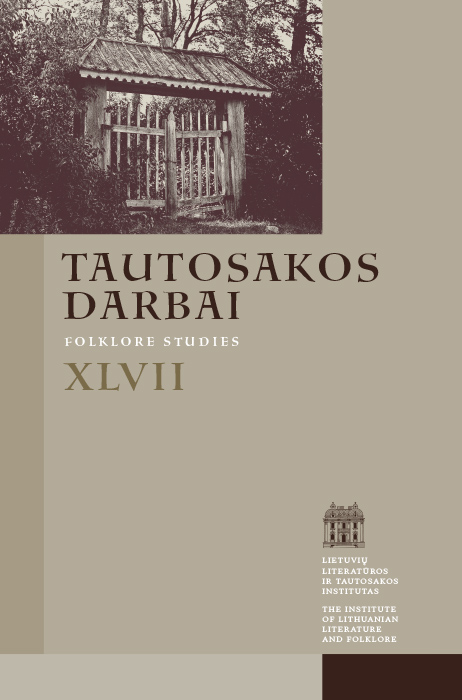The Actual Usage of Paremias in the Electronic Discourse: the Internet Comments
Abstract
This article marks the starting point for the projected successive research of paremias used in the electronic discourse. The communication in the virtual space, the so-called “talking in writing” is considered by the modern communication researchers to be relatively equivalent to the spoken language. Therefore this mode of communication is suitable for paremiology in view of searching evidence for the continuity of traditional usage of paremias and in defining its modern expressions. This time, a specific kind of the electronic discourse was picked out for the analysis, namely, the comments to the news articles. Paremias used in the comments to four thematically different articles published in the news portal delfi.lt are examined in the article. The analysis includes registering the number and peculiarities of the used paremias, establishing the extent that their usage is affected by the theme of the article, determining the intentions of their use and the possible characteristics of the users.
The modern society apparently has adopted mechanisms of the “paremic” thinking and speech, while using paremias in the comments to the internet articles can well be regarded as the actual living usage of paremias. It was established by the analysis that traditional paremias are more current in the internet comments rather than their transformations. Therefore question is raised, if this reflects the general pattern of using paremias in the electronic discourse and in the modern society, or if such proportion between the traditional and the modified paremias can be determined by the actual kind of the electronic discourse, namely, the internet comments. Presumably, the traditional paremias are handier as readymade phrases that can be spontaneously inserted into the comment. Besides, their general popularity ensures their greater effect and impact in comparison to the transformations, thus making them better means of persuasion.
The theme of the news article determines the choice of only those paremias that are directly related to it. Apparently, in the comments to the article discussing a certain famous personality, the evaluating paremias or those describing some personal features are more numerous, while in the comments to the articles dealing with universal problematic, the generalizing paremias prevail. Some paremias are used as reactions to other comments; these can therefore be totally irrelevant to the theme of the article.
Analysis of the actual position of paremias in the structural pattern of the comment reveals similarities of this “genre” both to the spoken language and to the media discourse. Using of paremias in the coherent text of the comment in order to summarize the expressed view or simply in order to state the commenter’s opinion is typical for the oral tradition. While using of paremias to entitle the comment or as the introductory phrases is typical for the journalism.
Paremias used in the comments allow for conjuring up just a very general and sketchy socio-psychological portrait of the commenter. This person can be male or female, rather well-educated and civilized, characterized by his / her need for public self-expression and eager to find additional means emphasizing his / her individuality. This person is both creative and resourceful, and, most importantly, a bearer of the actual tradition of using paremias.
Downloads
Most read articles by the same author(s)
- Dalia Zaikauskienė, Interpretation of Proverb Meaning: Theory and Practice , Tautosakos darbai: Vol. 62 (2021)
- Dalia Zaikauskienė, The Flowering Fences and the Greener Grass on the Other Side of Them: Reasons for Borrowing Paremias and Prerequisites for Their Adaptation , Tautosakos darbai: Vol. 58 (2019)
- Rūta Žarskienė, Inga Vidugirytė, Asta Skujytė-Razmienė, Gražina Kadžytė, Lina Leparskienė, Vita Džekčioriūtė-Medeišienė, Dalia Zaikauskienė, Chronicle , Tautosakos darbai: Vol. 58 (2019)
- Dalia Zaikauskienė, The Power of Proverbs , Tautosakos darbai: Vol. 59 (2020)
- Dalia Zaikauskienė, Kasmetinis tarpdalykinis patarlėms skirtas kolokviumas Portugalijoje , Tautosakos darbai: Vol. 66 (2023): Tautosakos darbai
- Dalia Zaikauskienė, Lilija Kudirkienė, The Way to Proverbs. Dalia Zaikauskienė interviewing paremiologist Lilija Kudirkienė , Tautosakos darbai: Vol. 61 (2021)
- Lina Būgienė, Dalia Zaikauskienė, Foreword , Tautosakos darbai: Vol. 58 (2019)
- Dalia Zaikauskienė, Profesoriaus Kazio Grigo 100-osioms gimimo metinėms skirta tarptautinė konferencija , Tautosakos darbai: Vol. 67 (2024): Tautosakos darbai




